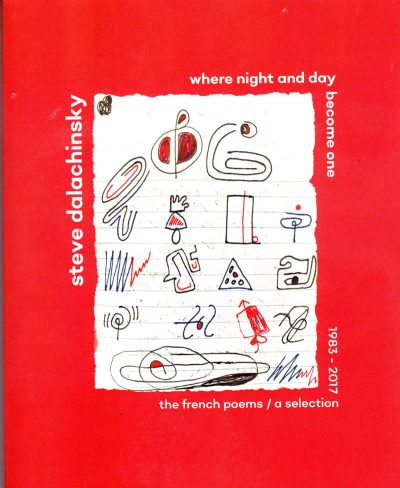where night and day become one
the french poems /1983-2017
by Steve Dalachinsky
Great Weather for Media, NYC, 2018
Steve Dalachinsky is a poet /cultural reporter of our time, not only via his essays, but also through his poetry. His territory includes free jazz (the Vision Festival) experimental gigs (e.g., at The Stone in the East Village), literary events of the Unbearables (a colorful group of poets, performers and writers he is sometimes associated with) and much more, most often taking the form of small books and his monthly Outtakes column in the Brooklyn Rail magazine.

Dalachinsky’s latest book, where night and day become one, french poems /1983-2017 can be viewed as a diary and/or a post-beat travelogue, humorous snapshots from the poet’s life as viewed through a distorted lens, and the people he meets, whether actually or in ghostly encounters. Sometime he is a guide to the Underworld, “beneath the underground,” with a little help from Bill Dixon’s famous lecture at Paris University: “NO ONE KNOWS ANYTHING.”
One could be forgiven for calling what he does a neat trick of self-historization, his personal take on the human condition in France and America via surreal pairings: Louis the 14th meets Louis Armstrong, Pasolini meets Dino Pedriali (for a nude photoshoot), Rimbaud and Baudelaire encounter Kerouac, Lady Day and Bird. Dalachinsky is busy conjuring a dream-like literary mindscape peppered with head-spinning references, using an erudite knowledge, ostentatious name-dropping and a post-beatnik morphistic narrative of rare synchronicity. A perfect collage of cut-ups; train-of-thought à la Allen Ginsberg; an awkwardly unsettling geography laced with hidden meaning.
Dalachinsky’s self-deprecating humor does not diminish the literary value of his poetry, rather it enhances the general gestalt.
The book is divided into six non-chronological chapters with dramatic references to locations such as Rue de Martyrs, La Mouffe, Jardine de Luxembourg, Giverny, AIX–en-Provence and many other destinations appealing to connoisseurs of French culture and subculture. Welcome to “la guillotine” and “l’atelier tampon.”
Appealingly vexing is Dalachinsky’s non-chronological construction of chapters, an adventure marked by the names of certain locations or words that cannot be found anywhere else–even on Google.
The free-wheeling Dalachinsky jumps easily from free verse to concrete poetry, from chaotic typography to whimsical designs, word constructions and deconstructions, puns, sound percussion (“tachada, tachada”), plays on names and words à la Duchamp or “mailtrate de la langue a la Americane.”
Almost every summer he leaves the “mean streets” of New York and jets to the antique romantic-bohemian streets of Paris. Per the author, cemeteries like Père Lachaise are a must for the hipster looking for an ancestral or aesthetical communitarian connectivity, places named after dead poets: As Max Blagg says in a blurb ‘Following the ghost lit trail that perfume the ancient streets.’
In the poem “for Rilke,” the last verse goes “where the Night and Day become one,” which I assume accounts for the book’s title, deliberately part-cliché, part-mundane and part-new romantic.
“A voice in his head speaks to [him] in a language that he does not understand” and yet “another voice interprets it.” Hmm! And then: “documentation is complete, zajach, allelu, najare, nechman, adjelsten, leska.”
Others from this hip encyclopedia include Goya, Rodin, Cezanne, Baudelaire, Apollinaire, etc., all inspiring Dalachinksy’s sharp observations and font modulations, “a crucifix of assembled bones” appearing on the page as a cross (and written at the Musée Picasso).
Jazz aficionados: Charles Mingus (“trial & error,” “the sacred heart of charles mingus”) and Ted Joans are the subject of several vivid poems that I re-read several times aloud, mimicking the author’s distinctive style of repeating and accentuating the last word. Dalachinsky is a musical persona in search of sounds: “no poems come from rain tho there is mesmerizing slight drizzle on window panes…. waiting for the music to begin/but what if inside me there is nothing?”
The end of another poem reads sadly: “a BLACK HOLE is essentially a SPACE where the LIGHT enters but cannot escape” (written “on plane landing in Marseille 5/2005”).
The poet drifts out-of-body, watching himself from the rear, analyzing, philosophizing and musing on the mysterious world of Paris: “complicit i watch them appear & disappear like windows of mist, permeating or whipped mortal climes i watch them from the back I watch them.”
My favorite verses are: “your hands,” composed at 6:20 a.m. in “Puget-ville 5/6/2005” and addressing a loved one, “as your skin becomes a thin casing for disappearing bones, like a skin of a drum wearing thin… I dream… that you might be miraculously cured so I might want all of you here with me right now as the sun begins to cross the roofs across the way & the wind makes the leaves into hands.”
Dalachinsky’s doodles and drawings, his multi-dimensional jazz-poetry-collage fusion, offer master techniques of absorbing and creating on-the-spot riffs of profound sadness and joy.
–Valery Oisteanu
Poetry Reviews
Lectori Salutem
I am searching hi and low for contact details (email) to get in touch with Steve Dalachinksy. I am a writer from Holland and currently working on an anthology about outlaw/beat poetry. I would like to include a Dalachinsky poem (Patti Smith’s Fingers).